You’ve probably been there: You’re scrolling through glowing reviews of a new restaurant, getting hungrier by the minute, when suddenly — bam. A few brutal 1-star reviews hit you like an online ton of bricks.
You notice the restaurant replied “Thank you!” to a couple of the good ones but completely ignored the bad. Suddenly, that new place “everyone’s talking about” doesn’t feel like such a safe bet.
Feedback is a gift for brands. Whether good or bad, it’s the clearest, most unfiltered way for customers to share their thoughts about your business with the world. With so many review platforms today (Google Maps, Yelp, G2, Trustpilot, Facebook, and more), your customers have more opportunities to share their opinions than ever.
Each time that happens, you get the chance to either turn a negative experience around or to reinforce a positive one.
Below, we’ll walk through real examples of brands — from small coffee shops to million-dollar businesses — that know how to respond to customer reviews. The example review responses are masterclasses in listening, adapting tone to match the customer’s, and artfully navigating both good and bad reviews.
Consider it your cheat sheet for crafting review responses that feel human, helpful, and on-brand.
When to respond to customer reviews
Do you need to respond to every single review? Technically, no.
But is it worth taking the time to address each one? Absolutely — especially the negative reviews.
Thoughtful replies to reviews show that you care, reassure future customers, and help diffuse doubts before they turn into lost business. Like that new restaurant I mentioned above, choosing to ignore negative reviews can hurt more than you think.
Ultimately, it’s up to you how much time and energy you dedicate to responding to reviews. Just remember: Reviews are a primary decision factor for potential customers, and the future of your business can depend on how you respond.
Pro tip: If you’re concerned about managing reviews, reputation management tools like Birdeye, Reputation, and Podium can help by aggregating reviews from many different platforms into one place.
8 examples of how to respond to negative customer reviews
Getting negative reviews from customers never feels good, but they shouldn’t be landmines to be avoided at all costs.
Responding well to negative reviews requires some extra care and effort, but it’s well worth it. In addition to potentially saving your relationship with that existing customer, a great review response will influence every future customer who sees it.
1. Restaurant review response
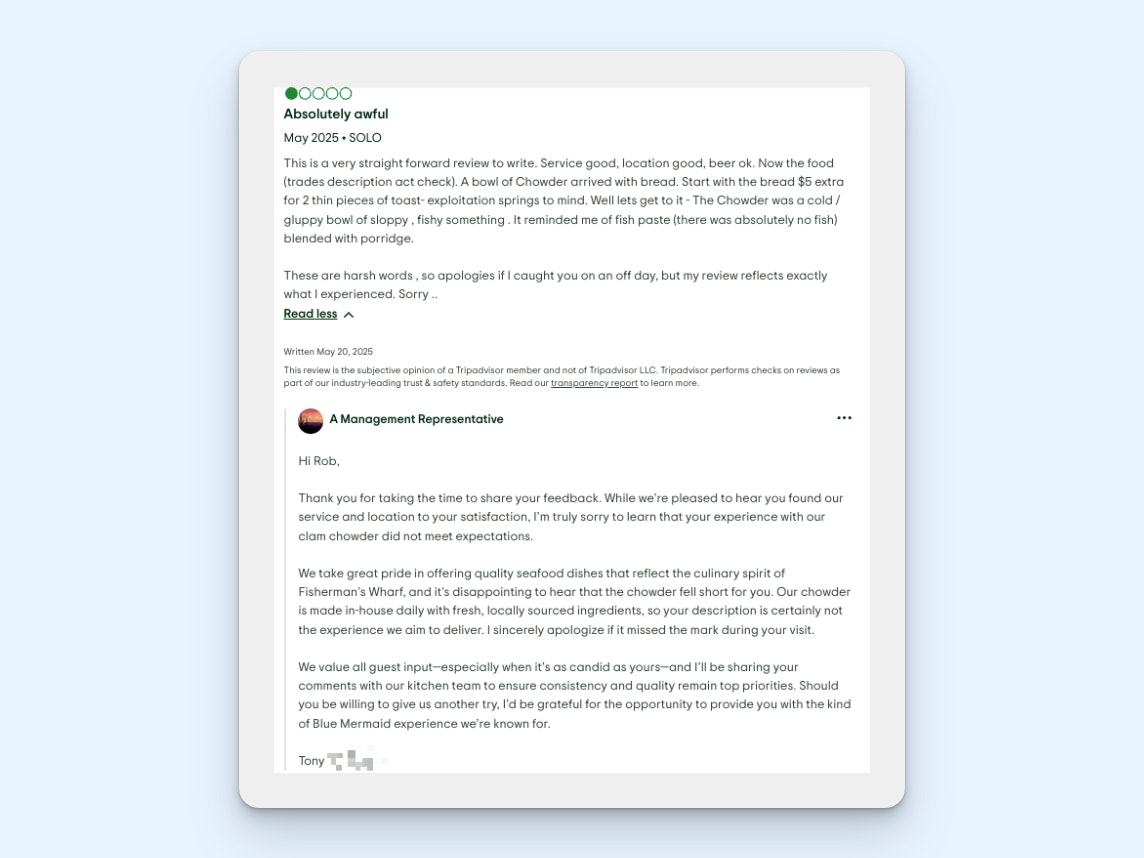
When a review comes in hot, this is how you keep your cool.
Instead of getting defensive, this restaurant leans into transparency, reassures the customer about cooking things in-house, and offers a genuine apology without sounding scripted. It’s the perfect reminder that even when the feedback comes in the form of “sloppy and fishy something,” a thoughtful, grounded reply can keep the conversation constructive and your reputation intact.
While this diner may or may not have returned, this review response is thoughtful and balanced, and it says a lot to future customers considering dining at Blue Mermaid.
2. Beauty salon review response
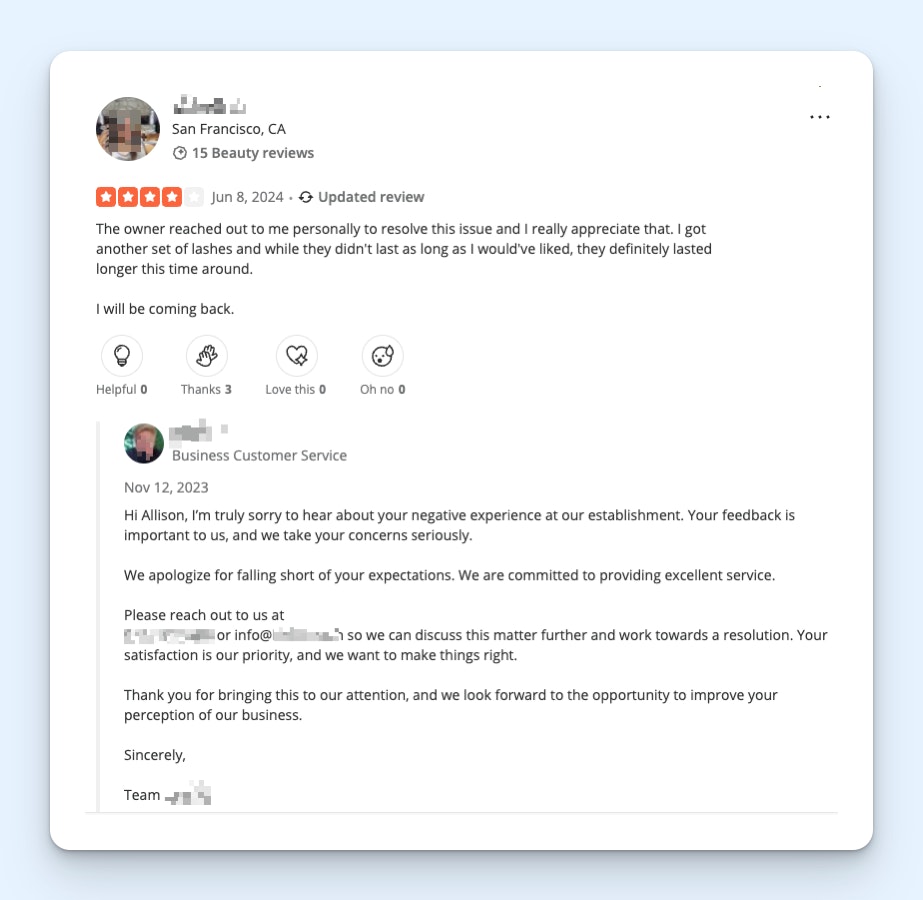
The business doesn’t just apologize — they open the door to actually fixing the problem. By giving the customer a direct phone number and email, they make it easy to reach out so they can make things right.
This type of response paid off: The reviewer updated their review to say the issue was resolved and that they’ll be coming back. It’s a perfect example of how a thoughtful, actionable response can turn a negative review into a positive situation, even for a small business.
3. Cafe review response

This neighborhood cafe handles a tough review with real grace. Instead of getting defensive, they apologize sincerely, acknowledge the customer’s experience, and extend a warm invitation to return, even offering a personal introduction to their coffee.
It’s friendly, calm, and open-hearted, showing they care without ever implying the customer is wrong. I particularly like how personal this feels. While that may not be the right way for a SaaS company to respond, it’s the perfect tone for a small neighborhood cafe.
4. Spa review response
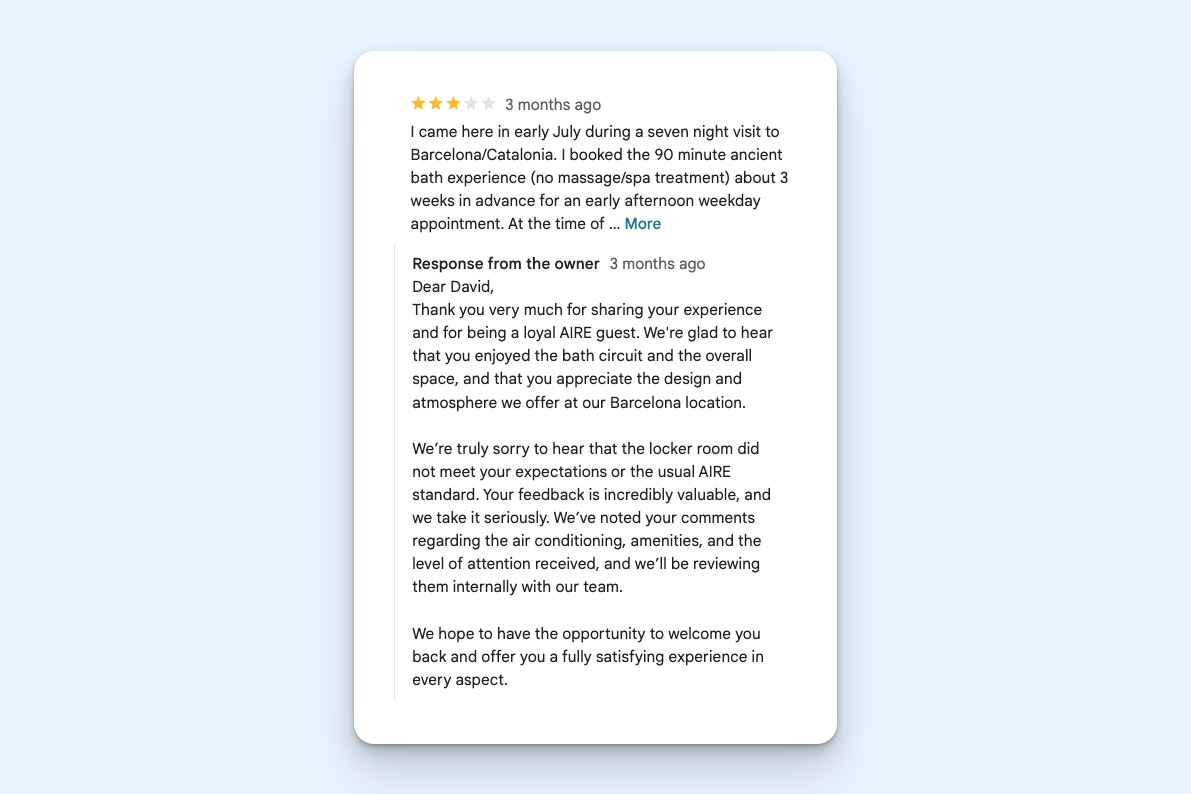
In this customer review, the business strikes a great balance: They thank the guest personally, acknowledge what went well, and address the issues without any defensiveness. They validate the feedback, explain that it’s being reviewed internally, and end with an inviting, forward-looking message.
It’s thoughtful and professional, and it shows genuine commitment to improving the experience.
5. Restaurant review response
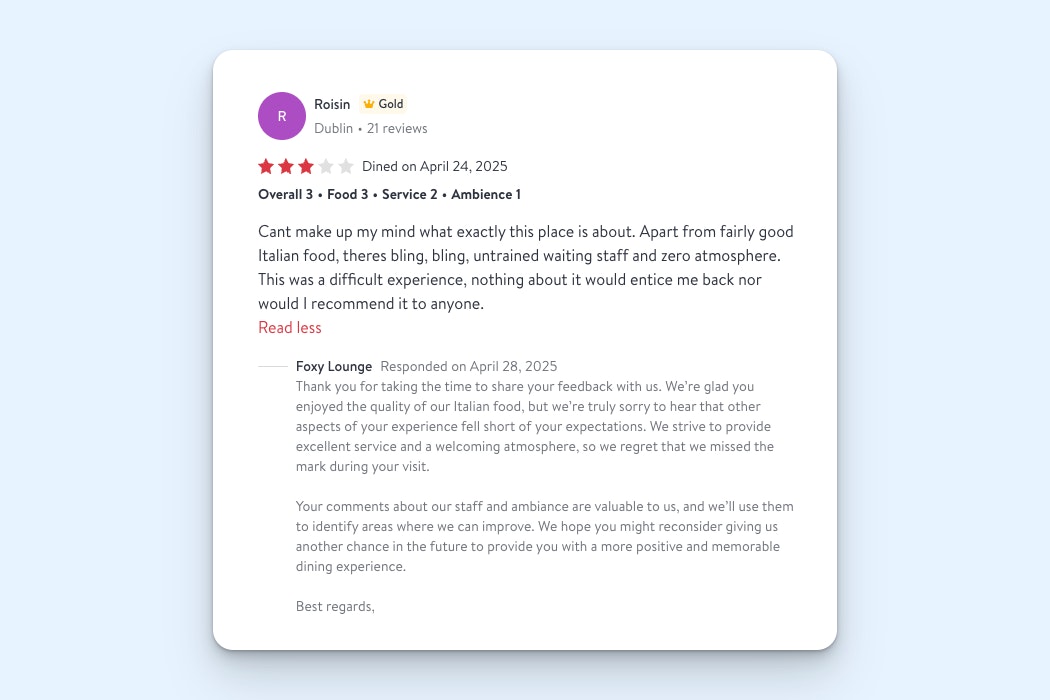
This restaurant handles a tough review with a calm, balanced response. They acknowledge what the customer liked, address the shortcomings without making excuses, and explain how the feedback will be used to improve the customer experience. By ending with an invitation to return, they keep the door open. That’s a smart move that shows a genuine desire to make things better.
6. Rental service review response
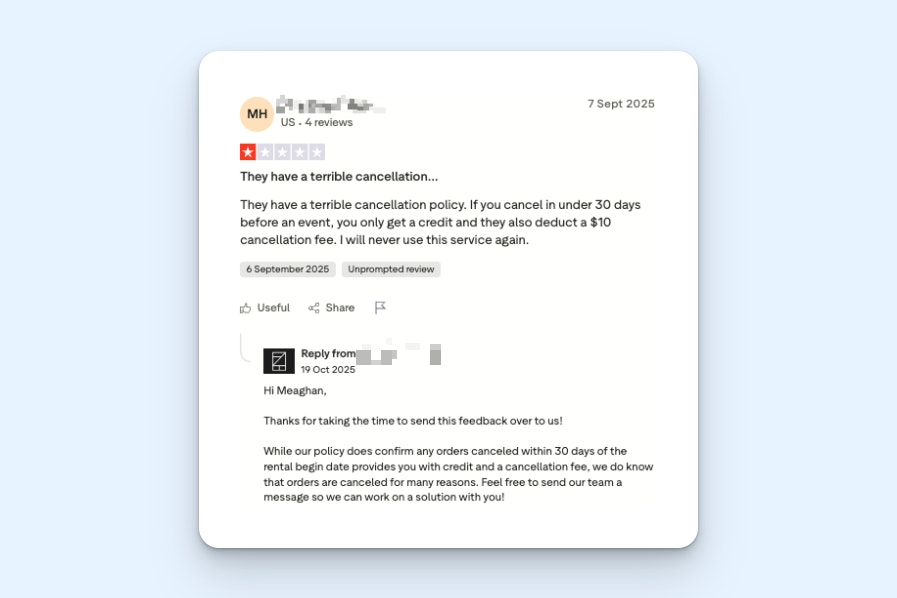
The business starts on the right foot by addressing the customer by name, a small touch that makes the response feel personal rather than canned. They explain their cancellation policy without getting defensive, and then go a step further by inviting the customer to reach out so they can work on a solution together.
While we’ll never know what happened here, this approach clearly demonstrates a flexibility and willingness to understand and work with customers, which is a smart move for any business.
7. Fashion brand review response
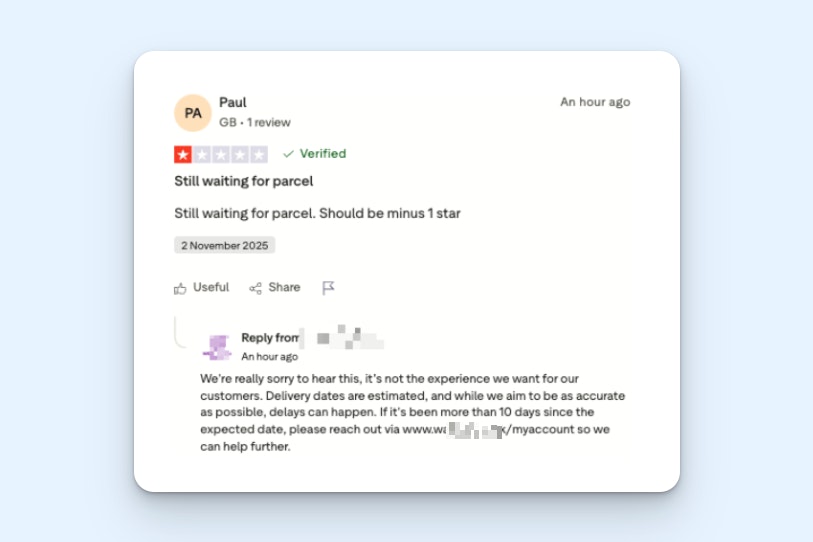
Sometimes reviews aren’t particularly detailed. This one probably could have been a support ticket, but the customer chose to leave a review instead.
Despite the situation, the brand keeps the response practical and reassuring. They clarify how delivery estimates work, acknowledge that delays can happen, and, importantly, tell the customer exactly what to do next. By giving a clear threshold (10 days) and a link to get further help, they guide the customer toward a solution.
8. Payment service review response
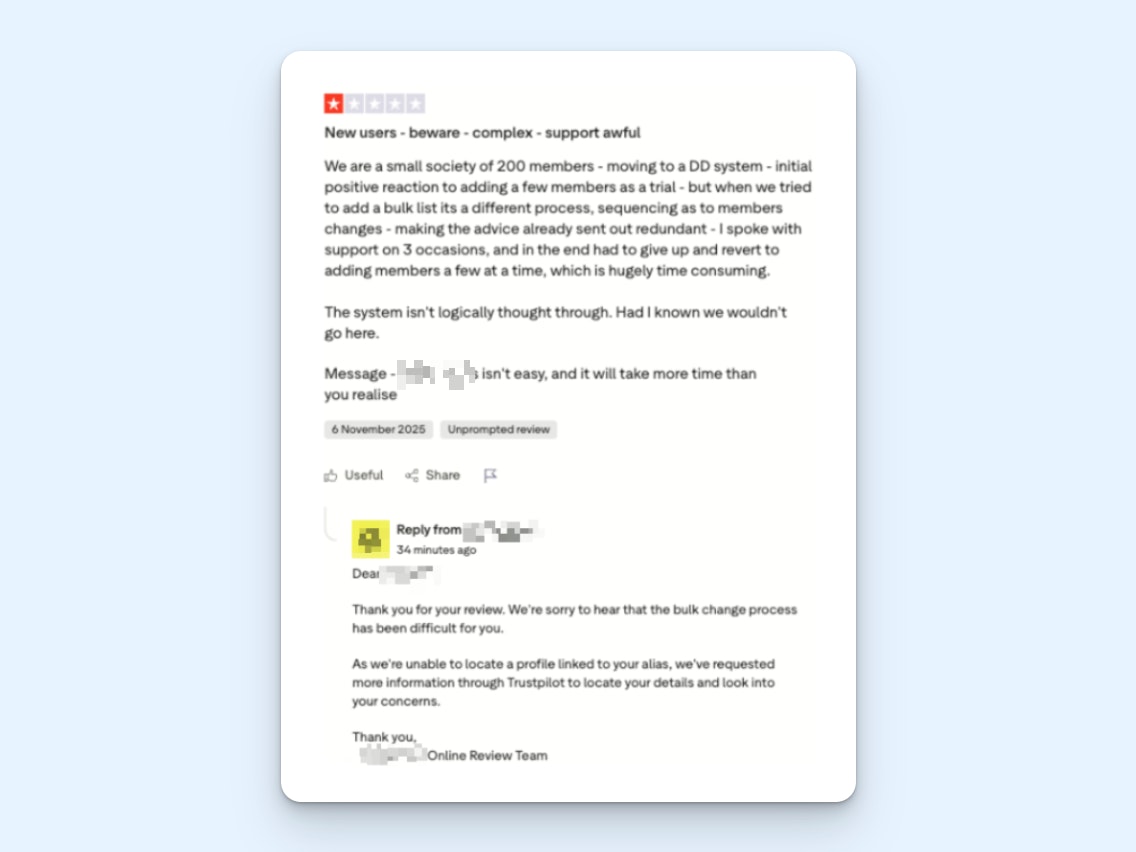
This review response is a little different than the others we’ve seen. While the customer is clearly unhappy, the company doesn’t just apologize. They acknowledge the situation, but then they demonstrate a proactive approach by sharing that they’re trying to track the customer down to provide assistance.
When they couldn’t find a matching profile, they mention they’ll use Trustpilot’s tools to request more details. It’s a clear message that this brand is not just about talking but about doing.
6 examples for how to respond to positive customer reviews
Glowing customer reviews deserve more than a dull “Thank you for your feedback!”
These five examples show you how to respond to positive customer reviews by mirroring a customer’s joy, sprinkling in specifics, and turning simple appreciation into a loyalty-building moment.
Sometimes acknowledging and celebrating the good stuff can be just as strategic and impactful as damage control.
1. Hotel review response

This review does well at mirroring the reviewer’s details (post-cycling trip, spa treatment, shout-out to an employee), which makes the guest feel seen. It’s warm and specific, and it closes with an invitation to return. These are all signs of a brand that cares, and they’re especially important when you’re in the hospitality industry.
Here’s a quick bonus tip: Naturally weaving in the hotel name, location, and amenities or services can improve your SEO without sounding forced.
2. Restaurant review response
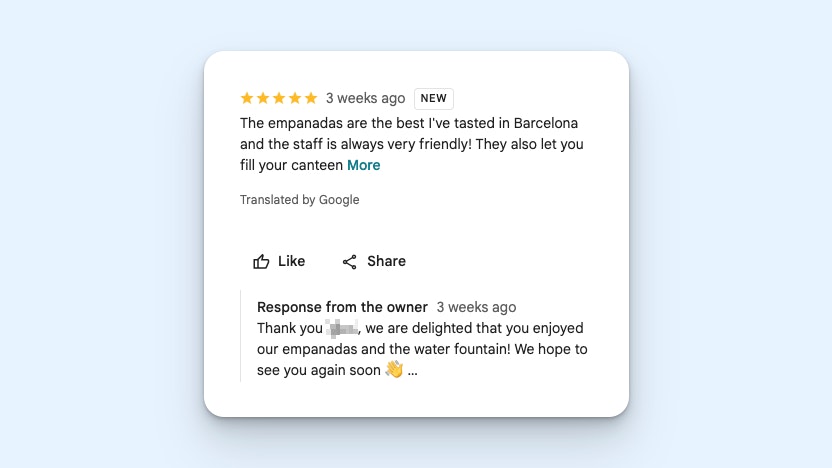
Depending on the platform and your customer’s tone, sometimes it’s okay to use more casual language in a review response. This restaurant keeps things lighthearted and genuine by adding emojis, something totally fitting for their vibe.
It’s short, sweet, and personal, showing that not every great response needs to be long or formal to make an impact.
3. Tour company review response
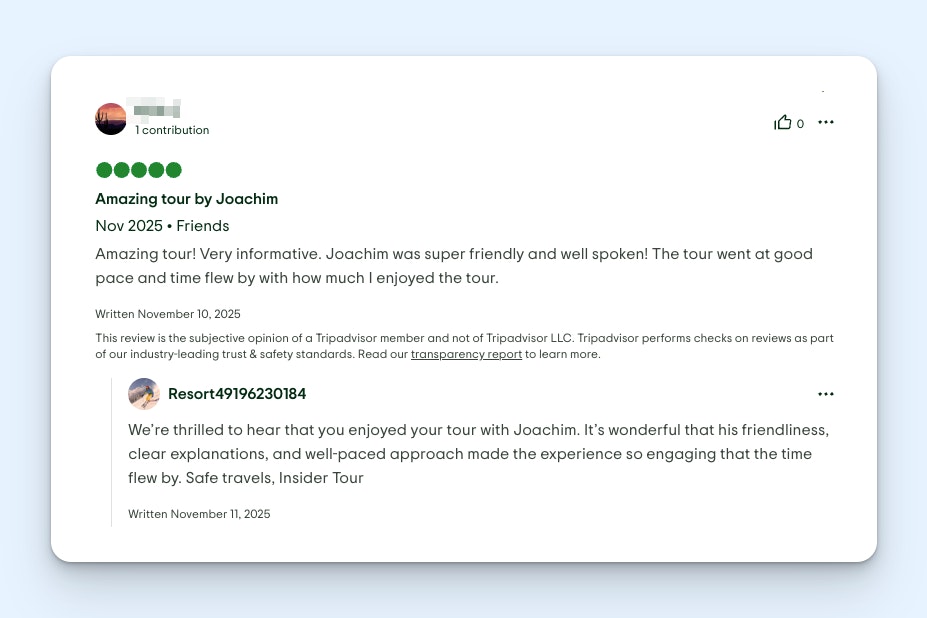
Employees often act as the face of your brand, and I love how, in this example, both the review and the company’s reply draw attention to the employee’s positive impact on the customer. By echoing the customer’s positive points about the employee, the brand subtly indicates that it’s listening and paying attention.
This review also stands out in one other way: timeliness. While it’s easy to overlook, the fact that the resort responded back the very next day is a big deal, and it shows they understand and are eagerly looking for feedback from customers.
4. Restaurant review response

This reply strikes a good balance between friendly and professional. The restaurant thanks the customer for coming back and echoes the things they valued about the experience. Because of that, the review response feels genuine and meaningful.
While it isn’t flashy, it’s a great example of how a simple, personal response can play a part in turning a happy customer into a loyal regular.
5. Accounting service review response
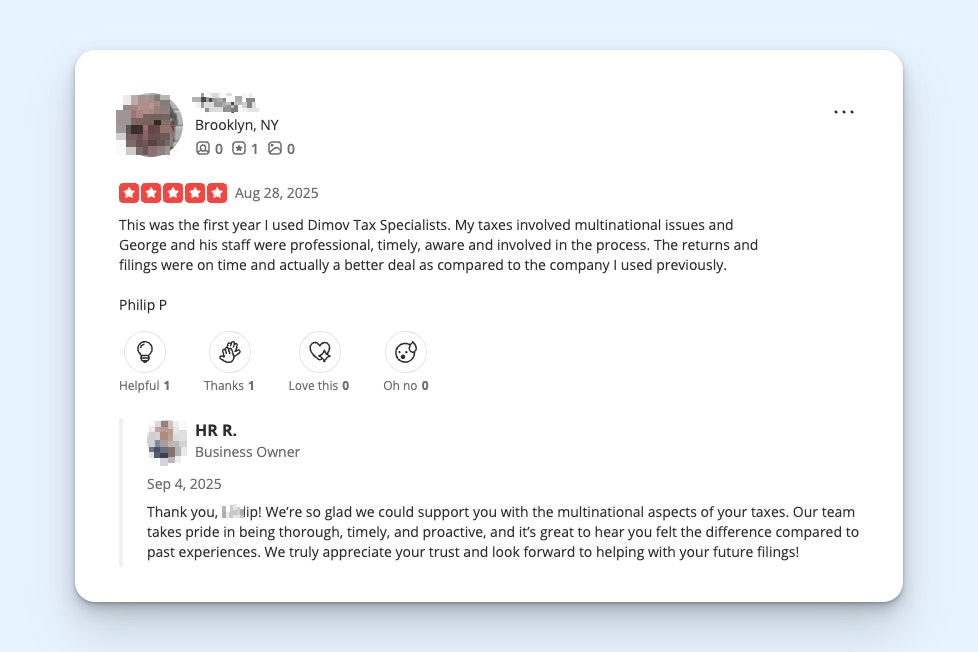
In this example of how to respond to a positive customer review, you’ll notice the thoughtful sign-off: “We truly appreciate your trust and look forward to helping with your future filings!”
This is obviously tailored to the tax services industry, and it makes the response feel more genuine and inviting. By thanking the customer by name and expressing excitement about supporting them again, the business turns a simple reply into a subtle relationship-builder.
6. Mobile network review response

This is a good example of a response to a positive review from a big brand. While Vodafone Ireland seems to have a centralized team managing review responses, they responded to the review quickly and effectively.
The response does a few things well: It thanks the customer by name, acknowledges the shoutout to an employee, and makes it clear the praise will be passed on. They also reinforce that this kind of experience is exactly what they strive for, turning this positive review into an affirmation of their values and reinforcing their brand.
Mistakes to avoid when responding to customer reviews
We’ve covered how to respond to customer reviews, but knowing what not to do is just as important. After all, even the best intentions can go sideways when responding to public reviews.
Let’s make sure you don’t make these common mistakes.
Over-relying on AI
It’s fine to use AI tools to help you draft or structure your response. They can save time and help you get the tone just right. However, copying and pasting the same AI-generated message across multiple reviews is a mistake. Customers can spot generic or robotic replies instantly, and it sends the message that you don’t actually care.
For example, one Reddit user captured this frustration perfectly:
Personally, I’d rather receive no reply to my review than receive one that was written by ChatGPT. It’s insulting to me to spend the time giving feedback only to know that they aren’t doing anything more than copying and pasting it into AI software, and it will likely never be read by any human staff. What do you think?
Overreliance on AI for review responses might help you win on efficiency, but it’s at the risk of alienating customers. It’s usually better to opt for a hybrid approach, using AI to assist empathetic human team members.
Ignoring feedback
Every review, positive or negative, is a data point. Within them are signals about processes that don’t work, training gaps, or opportunities to improve a product or service. Of course, not every piece of customer feedback deserves action, but recognizing which ones do is a critical skill every business needs to develop.
The key is to look for trends. If you get five reviews mentioning the same pain point, that’s not a coincidence. It’s a signal that you may be overpromising or miscommunicating or that something in your process is consistently breaking.
Reviews aren’t just about your reputation. They’re a great source of operational insight and opportunities to improve.
Addressing only positive reviews
You might wish negative reviews didn’t exist, but ignoring them won’t make them disappear. For potential customers, it’s jarring to see a business cheerfully replying to every glowing review while turning a blind eye to the constructive ones.
It makes people wonder how you’ll respond if their experience goes poorly.
The reality is simple: Good and bad reviews are part of doing business, and there’s value in all of them. Respond to negative reviews with kindness, curiosity, and care, just like you would if a customer shared feedback in person.
Copy-pasting responses
Templates are useful, especially if you experience a high volume of reviews, but they should never replace thoughtful engagement.
Writing cookie-cutter responses, in the style of “At [Company X], we take all customer feedback seriously as this allows us to continuously make improvements to our products, services and network,” on every single negative review might sound better than nothing, but just like when you rely too heavily on AI, it can come across as impersonal and lazy.
Instead, start with a few different templates and personalize them. Mix and match different elements. Just like in many of the examples above, make space in your response to echo what your customer mentioned in their review.
Not addressing the problem
Apologizing is a start, but it’s not always enough. Put yourself in the shoes of a potential customer: If they see a bunch of review responses saying “sorry about that” but never appearing to fix the issue, that’s a major red flag.
Even if you can’t fix the issue directly from the review platform, you can guide the customer toward the right next step, such as an email address, support form, or phone number to review their situation in detail.
If the review platform gives you enough context (like a username or order reference), try to identify and follow up proactively. Customers notice when brands make that extra effort, and a helpful reply can turn a public complaint into a trust-building moment.
Responding too late
I once received a reply to a positive review I’d left a full six months after posting it. By the time they responded, I didn’t even remember leaving the review in the first place. That particular review didn’t require a significant response, but getting one so late made the company seem disorganized and out of touch.
It’s even worse when the delayed reply is to a negative review. Negative reviews often highlight immediate issues, and a late response signals you’re not listening when it matters most. Try to respond within a few days to show attentiveness, professionalism, and care about your customer’s experiences.
Being defensive
You should never be rude to a customer. That rule is even more important when the conversation is public. Your customer won’t always be right, but arguing back or trying to “set the record straight” almost never ends well.
Keep your tone calm, factual, and respectful. By graciously responding to both positive and negative reviews, you demonstrate to everyone reading that your business values professionalism and pays attention to the details.
Building trust, one review at a time
How you respond to customer reviews — the glowing, the lukewarm, and the brutally honest — is a big part of showing your customers that you care.
That’s true for the individual leaving the review, but it extends far beyond that to every possible future customer that’s researching your brand or business. Whether you’re celebrating a stellar experience or trying to fix a terrible one, your goals should always be the same: Listen well, acknowledge what’s been shared, and keep the door open for more communication and more business.







